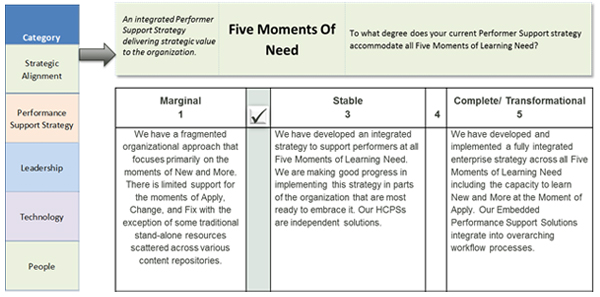At the narrow mouth of the American Fork Canyon in Utah, there is a tree grasping to the side of the steep south slope (Figure 1). The ground is literally moving out from under that tree. Its root system clings tenaciously to its unstable spot. At some point, though, it won’t be able to hold on; it has simply rooted itself in the wrong place. Now consider this: are you in a similarly precarious spot? Are you, and those with whom you work, clinging to a formal learning mindset that threatens the very survival of your company?

Figure 1: Rooted in the wrong spot
Are you building on shifting ground?
Most organizations today face a competitive landscape that is constantly shifting out from under them. Few are prepared to survive the kinds of seismic market shifts that are part and parcel of today’s “New Normal.” Your business’ survival requires the ability to grow, change, or innovate at or above the speed of its own market. It must be agile, and fully able to respond to adaptive challenge — be it an opportunity, a threat, or a crisis.
With such high stakes at risk, those with responsibility for learning and on-the-job support (e.g., departments such as learning and development, human resources, support services, and technical publications) need to replant themselves; they need to embrace a common mindset that will deliver effective performance at every changing moment. Only then does learning at the speed of change become possible.
An example of a failed strategy
Without this broader performance mindset, here’s what happens. We recently observed a participant in a mobile-learning workshop describe what her break-out group had accomplished in response to an assignment to design a mobile-learning app. Its purpose was to help store managers successfully open up their store each day and get it ready for business. With enthusiasm, she described a sequence of instructional experiences a learner could have via a mobile device. They included every dazzling bell and whistle possible, including gamification. It was an enticing design. Most of the 60 people in the room who heard it applauded the ingenuity.
The problem? What store managers really needed was an effective mobile-based performance-support solution that would guide them through the process as they did it. In this instance, store managers needed mobile support, not mobile learning. Any time spent in that mobile training course would have been wasteful and counterproductive.
The winning mindset
The discipline of performance support has awakened the two of us to the reality that all too often, much of what is done in the name of formal learning is unnecessary. Our ongoing analysis reveals that more than 50 percent of the tasks and concepts scheduled for formal instruction (classroom or eLearning) don’t really require training. Instead, all that’s needed is effective performance support made intuitively available at the moment of apply.
Now, please don’t misunderstand. There is great need for formal learning, but in today’s brutal ever-changing environment, we are being asked to train people on more and more information in less and less time. Plugging everything into formal training potentially leads to rapid-paced content dumps laced with rushed practice activities. The result? Whatever learners feel they’ve learned simply fails to survive the rugged journey to on-the-job competence. Our organizations need us to be much more effective than this. They need us to deliver effective performance at every changing moment.
So, how narrowly do you view what you do? Table 1 offers you a chance to check your own mindset by selecting which side of the line best describes how you are approaching your work today.
| Training Mindset | Agility Mindset | ||
|
I see training as the primary means for achieving effective on-the-job performance. |
|
|
I see training as just one of the means for achieving effective on-the-job performance. |
|
My primary focus is developing learning solutions. |
|
|
My primary focus is developing performance solutions. |
|
Training is my default solution when there is a performance gap. |
|
|
By default, I check to see if we can achieve effective performance without pulling people away from their work. |
|
I view my work through the lens of designing, producing, and implementing courseware that is aligned with business needs. |
|
|
I view my work through the lens of designing, producing, and implementing solutions that drive effective performance at every changing moment. |
Table 1: Which side of the line describes how you approach your work?
If you’re anywhere on the left side of the line in the table above, then you need to uproot your mindset and plant it more squarely on the right side. If you’re already fully on the right side of the line, congratulations; however, you’re still not necessarily on stable ground. Your organization’s mindset may be a different reality.
Figuring it out and taking action
We have developed a learning and performance capability analysis process that leverages a maturity model designed to help organizations optimize their capacity to learn at the speed of change. The following is one of the model’s 27 questions across five categories. The check shown on the rating scale below indicates where most organizations fall today. If you haven’t read “Are You Meeting All Five Moments of Learning Need?”, the second article in this series, do so and then use this rating scale (Figure 2) to check your own organization’s standing with the Five Moments of Need.

Figure 2: Use this scale to identify where you are regarding the Five Moments of Need
Is your mindset, and that of your organization, where they need to be to foster effective performance in an environment of unrelenting change? If your organization is hovering around 2 in the Five Moments of Need rating scale above, then it is in the wrong place, and it is time to uproot and replant. Here’s how to do it:
- Cultivate this broader view of what you do, and never lose sight of the real intent of all you do — delivering effective performance at every changing moment.
- Put in place a fully integrated learning and performance support strategy, along with the technology infrastructure that fosters and sustains it. Seriously study and embrace the principles presented in the previous articles of this series, and attend the Performance Support Symposium in Boston.
- Sort out where you are, determine where you need to be, then make a plan and go to work.
Andy Grove, Intel’s former CEO and chairman of the board, provides an important insight for you to consider in moving forward: “There is at least one point in the history of any company when you have to change dramatically to rise to the next level of performance. Miss that moment — and you start to decline.”
The shift described in this article is one of those moments. No organization can afford to continue to cling to a traditional formal learning mindset. The risk is too high. You will most certainly rise to the next level of performance as you move forward focusing on providing performers just what they need, at every moment of need, in the form needed, to ensure effective performance at every changing moment of need. Learning (be it experiential, via coaching, or formal via courses) may be a key part of that journey, but there is much more to it. This is where you need to plant your organization and sink your roots deep.
ITT CEO Harold Geneen put it best when he said “Performance is your reality. Forget everything else.” That mindset led ITT from $765 million in sales to over $17 billion. Just think what the same mindset can do for your company.
The Performance Support Symposium 2012, a new event produced by Learning Solutions Magazine, offers you an exceptional opportunity to discover how organizations can leverage investments in training and eLearning by offering employees performance support tools so they can continue to learn while they work. You are invited to join other senior learning professionals in Boston for this deep exploration of strategies, technologies, and best practices for performance support. The time for performance support is now.




